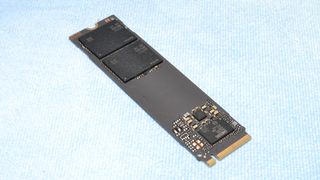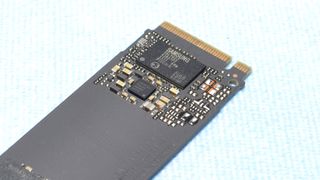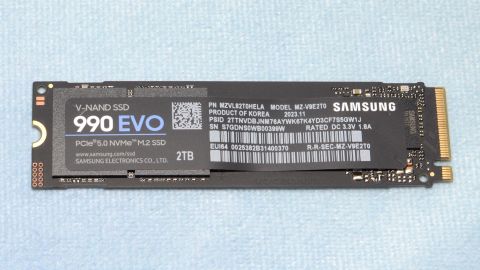Tom's Hardware Verdict
The Samsung 990 EVO tries to be too many things at once, falling short of the EVO name. Performance isn’t bad, but the drive’s power efficiency leaves something to be desired.
Pros
- +
Relatively good all-around and sustained performance
- +
Samsung software support and warranty
- +
Interesting interface modes
Cons
- -
Questionable MSRP
- -
Lackluster power efficiency and idle consumption
Why you can trust Tom's Hardware
The Samsung 990 EVO aims to be the new mainstream SSD darling, and nothing quite excites like the launch of a new Samsung SSD. Following on the heels of the excellent Samsung 990 Pro, the 990 EVO has big shoes to fill if it wants to live up to the EVO name. The 970 EVO Plus remains a highly-regarded SSD, and finally it has an enigmatic, hybrid PCIe 4.0/5.0 successor. It hopes to compete with the best SSDs, but what exactly is the 990 EVO trying to be?
Aside from an interface that can hop from x4 PCIe 4.0 to x2 PCIe 5.0, it arrives with a new 5nm controller with the promise of great efficiency gains. Yet the flash is more mundane, with reduced bandwidth in a DRAM-less design. At least it's a single-sided 2TB drive that can work well as a PS5 SSD or in your PC, though that's pretty common these days.
This is a drive designed for laptops, OEMs, and pre-builts, with enough performance for gaming and everyday activities. It’s no 990 Pro, but neither is it supposed to be. It fills a gap in the line and offers a pared-back experience at an ostensibly lower cost. You get the Samsung name with excellent software support in a reliable package. At least, that’s the idea.
Instead we found the power efficiency to be questionable and it feels like the drive is trying to do too many things at once, possibly as a reflection of the current SSD market. What results is a careful balancing act, but the real issue right now is that the Samsung 990 Pro 2TB can be had for $169, which is only $10 more than the Samsung 990 EVO 2TB.
Samsung 990 EVO Specifications
| Product | 1TB | 2TB |
|---|---|---|
| Pricing | $124.99 | $209.99 |
| Online Price | $99.99 | $159.99 |
| Form Factor | M.2 2280 (Single-Sided) | M.2 2280 (Single-Sided) |
| Interface / Protocol | PCIe 4.0 x4 or 5.0 x2 / NVMe 2.0 | PCIe 4.0 x4 or 5.0 x2 / NVMe 2.0 |
| Controller | Samsung Piccolo | Samsung Piccolo |
| DRAM | N/A (HMB) | N/A (HMB) |
| Flash Memory | Samsung 133-Layer TLC (V6P) | Samsung 133-Layer TLC (V6P) |
| Sequential Read | 5,000 MB/s | 5,000 MB/s |
| Sequential Write | 4,200 MB/s | 4,200 MB/s |
| Random Read | 680K | 700K |
| Random Write | 800K | 800K |
| Security | TCG Opal 2.0 | TCG Opal 2.0 |
| Endurance (TBW) | 600TB | 1,200TB |
| Warranty | 5-Year | 5-Year |
The Samsung 990 EVO is available at 1TB and 2TB with a $124.99 and $209.99 MSRP, respectively. Street prices are already significantly lower, at $99 and $159 — which is important considering prices on the competing and superior Samsung 990 Pro. SSD prices are expected to rise significantly this quarter, but the 990 EVO’s 1TB MSRP is not far off of the Crucial T500 2TB’s current sale price of $149.99.
The Samsung 990 EVO is rated for up to 5,000 / 4,200 MB/s for sequential reads and writes as well as up to 700K / 800K random read and write IOPS. QD1 random read and write IOPS can hit 20K / 90K. It has the standard 5-year, 600TB of writes per TB capacity warranty. The drive does support TCG Opal 2.0 for encryption, which would make it a nice pick for laptop users in particular.
The drive also operates in both x4 PCIe 4.0 and x2 PCIe 5.0 modes, which adds some flexibility for future mobile platforms. Note that in our testing, performance between the two modes was generally similar, with PCIe 4.0 x4 coming in slightly ahead overall.
Samsung 990 EVO Software and Accessories
Samsung has the best software support in the business. Samsung Magician is the gold standard for SSD toolboxes, and Samsung also offers its Data Migration software for cloning. Magician is chock full of information and features, which includes the ability to enable encryption. We do not recommend choosing an SSD for its software support alone, but if you’re the type who likes this sort of package — especially for laptops, with this drive — then this might be a deciding factor for you. Samsung does tout its firmware support, which has been useful in fixing issues in the past.
As a final note, there is no need to use an NVMe driver with this or most SSDs. The 990 EVO is not present in the list of supported drives for Samsung’s driver, either. Microsoft’s stock driver provides full functionality. The only exception is with some Intel and Solidigm drives, like the P41 Plus, that can make use of Solidigm’s Synergy driver and software. That said, even though driver support ended with the 980 Pro it was possible to use Samsung’s driver for some performance uplift, but we do not recommend this.
Samsung 990 EVO: A Closer Look





The 990 EVO is DRAM-less and single-sided with two NAND flash packages. The drive runs in both x4 PCIe 4.0 and x2 PCIe 5.0 modes, a fact that has led some to call it a “FrankenSSD.” The drive will automatically select the best mode based on the host slot — which in practice means it will operate in PCIe 5.0 x2 mode if you put it in a 5.0 slot.
Our expectation is that the drive should be a little bit more efficient in the latter mode, but otherwise the bandwidth is the same. There have been cases in the past when some laptops would run NVMe SSDs with two lanes as a sort of power-saving function, and we’ve also looked at Phison’s link state throttling in the Corsair MP700 that reduces link speed. Samsung’s decision indicates this drive is created to be more flexible for prebuilts and laptops.

The 990 EVO uses Samsung’s DRAM-less Piccolo controller matched with 133-Layer TLC NAND flash. This controller is also used in the PM9C1a client SSD, and it appears there’s also a version of it for QLC dubbed the PiccoloQ. The Piccolo is a four-channel design capable of bus speeds up to 2,400 MT/s, which theoretically puts it on par with the Maxio MAP1602 in the Lexar NM790 as well as the new Phison E27T controller. It also matches the Phison E25 in the Crucial T500, although that controller has DRAM, a potentially important factor to consider when making your purchase.
However, the 990 EVO taps out around only 5,000 MB/s and the PM9C1a hits up to 6,000 MB/s, both short of what can be achieved with this controller. For the 990 EVO this is because the V6P TLC runs at 1,600 MT/s. The PM9C1a is using V7, or 176-Layer, TLC instead, which nominally runs at 2,000 MT/s. It would be possible to hit over 7 GB/s if the controller were to be paired with the 4TB 990 Pro's newer V8, 236-Layer TLC.
That's a lot of numbers to throw at you, but the bottom line is that the 990 EVO is competing more, on paper, with drives like the WD Black SN770 and Teamgroup MP44L, rather than the NM790 or T500. On the OEM side, it matches up against the SM2268XT-based Kioxia BG6.
The drive’s V6P TLC does differ from Samsung’s original 128-Layer V6 TLC that came with the 980 Pro. Samsung had issues with the 980 Pro and later adapted its manufacturing process. Better yields is one advantage of the 990 EVO’s V6P, the other being a bump from 1,400 MT/s to 1,600 MT/s. As such, it easily clears the hurdle of being a faster drive than ultra-budget options like the Kingston NV2.
The V6P flash also has high array efficiency in a single-stack configuration, which is the ratio between active word lines and total layers or gates. However, this technology is older than Samsung’s newer Cell-over-Peripheral (CoP) flash, so it remains to be seen how efficient it is.

Samsung tends to be tight-lipped about its controller details, but we have gleaned some information. It’s built with Samsung’s 5nm process technology and supports NVMe 2.0, so it should be efficient even with older flash. The controller design itself seems to follow Samsung’s mainline configuration, built around the ARM Cortex-R8 with multiple specialized cores for managing the flash. The Piccolo controller also relies on an auxiliary Cortex-R5 core, much like many Phison controllers. This allows for a division of labor for host communication, cache management, and the flash translation layer (FTL).
The Piccolo’s design, on paper, has a lot of horsepower, which unfortunately might negatively impact efficiency. This strategy might hinge on what sort of balance Samsung can find with the hardware. It may also be one reason Samsung has settled for lower speeds on the 990 EVO: It’s fast enough as is, and having a tight design will make the drive reliable for prebuilts and laptops.
Samsung finds ways to innovate, as it did with the 4TB 990 Pro, but we’ll have to see what this brings to the table aside from the flexible interface. The E27T and MAP1602 controllers will give the Piccolo a run for its money as higher speeds, when paired with faster memory, can result in quicker workload completion — these controllers, paired with 232-Layer flash or BiCS6, are very fast and efficient.
Samsung’s utilization of older flash is also making the best of a bad situation. The recently-released T9 portable SSD is using Samsung’s 6th generation flash. Other drives, like the 870 EVO, have been updated to the newer V6P flash that’s also found on the 990 EVO. This flash is still generationally behind what’s found on the 990 Pro, which may be disappointing for those who expected more out of an EVO product. The 990 EVO is, instead, more like the Samsung 980, at least in theory.
MORE: Best SSDs
MORE: Best External SSDs and Hard Drives
MORE: How We Test HDDs And SSDs
MORE: All SSD Content

Shane Downing is a Freelance Reviewer for Tom’s Hardware US, covering consumer storage hardware.
-
Notton If it hits 74C on a desktop, it's going to hit 85C in a laptop. Unless you add a heat-spreader.Reply -
Amdlova Reply
That heat comes from the speed of TLC burning the rated endurance.Notton said:If it hits 74C on a desktop, it's going to hit 85C in a laptop. Unless you add a heat-spreader. -
yeyibi ReplySamsung has the best software support in the business
Actually, to extract the performance it sells, it needs Samsung Magician, a software that is always broken. Always fails to load with windows. Always disappears from the system tray.
Samsung released dozens of versions of Samsung Magician, and every one is broken. -
scrumpydrew Reply
I've been using Samsung SSDs with Magician for 10 years and never had any issues?yeyibi said:Actually, to extract the performance it sells, it needs Samsung Magician, a software that is always broken. Always fails to load with windows. Always disappears from the system tray.
Samsung released dozens of versions of Samsung Magician, and every one is broken. -
USAFRet Reply
My Magician installs don't do that.yeyibi said:Actually, to extract the performance it sells, it needs Samsung Magician, a software that is always broken. Always fails to load with windows. Always disappears from the system tray.
Samsung released dozens of versions of Samsung Magician, and every one is broken.
Across several systems. -
Heiro78 I gotta say, you do great work. And I hope it's to your continued benefit that you are freelance versus a direct employeeReply -
yeyibi Reply
Lucky you. I had seen it broken on dozens of machines, specially with SATA units.scrumpydrew said:I've been using Samsung SSDs with Magician for 10 years and never had any issues?
Just a week ago, Somebody asked me to fix his laptop, and there was the Magician, last version, broken just after the first reboot of a clean windows installation. -
scrumpydrew Reply
Hmm, maybe it's a SATA specific issue. Still, I must've hit the lottery with the software never busting on meyeyibi said:Lucky you. I had seen it broken on dozens of machines, specially with SATA units.
Just a week ago, Somebody asked me to fix his laptop, and there was the Magician, last version, broken just after the first reboot of a clean windows installation. -
USAFRet Reply
Magician works just fine with my 2x Samsung SATA drives. Both 860 EVO, 1TB.scrumpydrew said:Hmm, maybe it's a SATA specific issue. Still, I must've hit the lottery with the software never busting on me
As well as the 980 Pro.
